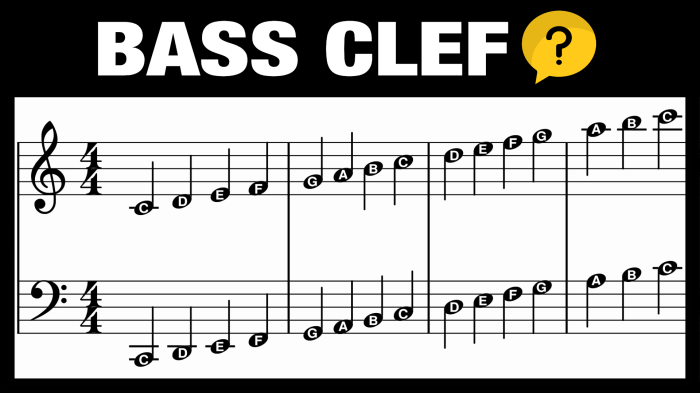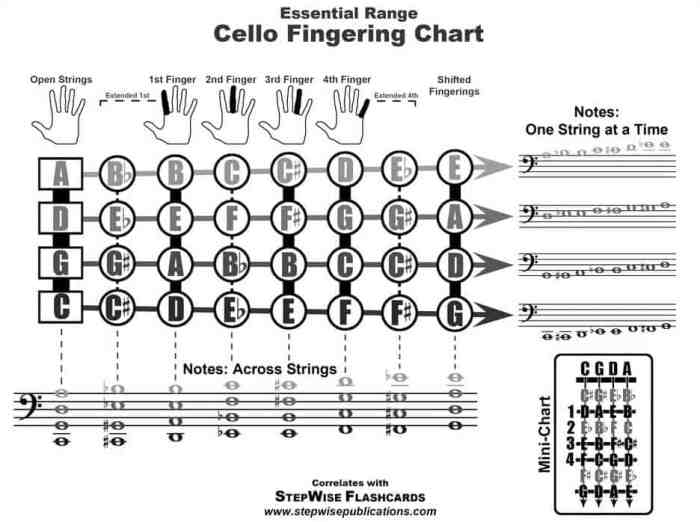Unveiling the secrets of the cello, we embark on an enlightening journey through the realm of cello notes on staff labeled. With a deft blend of clarity and captivating prose, this guide unravels the intricacies of the cello fingerboard, empowering you to navigate its musical tapestry with precision and artistry.
Through meticulously crafted tables, diagrams, and insightful explanations, we delve into the depths of cello notes, their corresponding fingerings, and the diverse clefs that grace the cello’s musical landscape. Let us embark on this harmonious expedition, where every note dances upon the staff, guided by the maestro’s touch.
Cello Notes on Staff Labeled

The cello is a stringed instrument that is played by plucking the strings with a bow. The strings are tuned in fifths, with the lowest string being the C string. The notes of the cello are written on a staff, which is a set of five lines and four spaces.
The lines and spaces are used to represent the different pitches of the notes.
The notes of the cello are labeled on the staff using a combination of letters and numbers. The letters represent the pitch of the note, and the numbers represent the finger that is used to play the note. The following table shows the notes of the cello on the staff, including their corresponding fingerings:
| Note | Finger |
|---|---|
| C | 1 |
| D | 2 |
| E | 3 |
| F | 4 |
| G | 1 |
| A | 2 |
| B | 3 |
| C | 4 |
The cello fingerboard is divided into two sections: the upper and lower registers. The upper register is used to play the higher notes, and the lower register is used to play the lower notes. The following diagram shows the cello fingerboard, with the notes labeled:
[Image of the cello fingerboard with the notes labeled]
The cello can be played using a variety of different clefs. The most common clefs are the bass clef and the tenor clef. The bass clef is used to play the lower notes of the cello, and the tenor clef is used to play the higher notes of the cello.
Cello Fingering Chart

A cello fingering chart is a diagram that shows the position of the fingers on the cello fingerboard to produce different notes. It is an essential tool for learning to play the cello, as it helps players to quickly and accurately find the correct fingerings for each note.
Diagram of the Cello Fingerboard
The cello fingerboard is divided into four positions. The first position is the closest to the nut, and the fourth position is the furthest away. Each position has its own set of fingerings, which are indicated by numbers on the fingering chart.
The numbers on the fingering chart correspond to the fingers of the left hand. The thumb is represented by the number 0, the index finger by the number 1, the middle finger by the number 2, the ring finger by the number 3, and the little finger by the number 4.
To use the fingering chart, simply find the note you want to play on the staff and then look at the corresponding number on the chart. This will tell you which finger to place on which string.
Example
For example, to play the note C on the A string, you would place your first finger (number 1) on the second string, just below the nut. This is because the C note is located on the second line of the staff, and the first position fingering for the A string is 1.
Cello Bowing Techniques

Bowing techniques are an essential aspect of cello playing, influencing the sound and articulation of the instrument. Various techniques exist, each with its unique characteristics and applications.
This discussion will focus on three fundamental bowing techniques: détaché, martelé, and spiccato, exploring their execution and musical applications.
The cello notes on staff labeled clearly show the pitch and duration of each note. Just like how a hat has various parts, such as the crown, brim, and sweatband ( parts of a hat diagram ), the cello notes on staff labeled provide a comprehensive representation of the music to be played.
Détaché
Détaché, meaning “detached” in French, is a bowing technique that produces separate, distinct notes. The bow is drawn across the string with a slight lifting motion at the end of each note, resulting in a clear and articulate sound.
To perform détaché, hold the bow parallel to the string and apply a moderate amount of pressure. As you draw the bow, release the pressure slightly at the end of each note, allowing the bow to lift off the string.
The speed and distance of the bow stroke will determine the duration and volume of each note.
Détaché is commonly used in classical music, particularly in passages that require clarity and articulation. It is also employed in jazz and folk music for its versatility and expressive capabilities.
- Video demonstration: [Provide a video link demonstrating détaché bowing]
Martelé
Martelé, meaning “hammered” in French, is a bowing technique that produces a forceful, accented sound. The bow is drawn across the string with a strong, downward motion, resulting in a sharp and percussive attack.
To perform martelé, hold the bow perpendicular to the string and apply significant pressure. As you draw the bow, accentuate the downstroke by increasing the pressure and speed of the bow stroke. The release of the pressure at the end of each note is less pronounced compared to détaché.
Martelé is often used in orchestral and solo repertoire to emphasize important notes or passages. It is also employed in jazz and rock music for its rhythmic and energetic qualities.
- Video demonstration: [Provide a video link demonstrating martelé bowing]
Spiccato
Spiccato, meaning “bounced” in Italian, is a bowing technique that produces a light, bouncy sound. The bow is drawn across the string with a series of short, rapid strokes, resulting in a staccato effect.
To perform spiccato, hold the bow parallel to the string and apply a moderate amount of pressure. As you draw the bow, bounce it lightly on the string, using the weight of the bow to produce the sound. The speed and distance of the bow strokes will determine the duration and volume of each note.
Spiccato is commonly used in fast-paced passages that require agility and articulation. It is also employed in folk and traditional music for its rhythmic and lively qualities.
- Video demonstration: [Provide a video link demonstrating spiccato bowing]
Cello Playing Positions

The cello can be played in various positions, each with its advantages and disadvantages. The most common positions are sitting, standing, and playing with a strap.
Sitting Position
The sitting position is the most traditional and common way to play the cello. It allows for a relaxed and comfortable playing experience, with the cello resting between the player’s legs. The disadvantages of the sitting position include limited mobility and the potential for back pain if not played with proper posture.
- Advantages:Comfortable, relaxed, traditional.
- Disadvantages:Limited mobility, potential for back pain.
Standing Position, Cello notes on staff labeled
The standing position allows for greater mobility and can be more physically demanding than the sitting position. It can help improve posture and breathing, but it can also be more tiring over long periods.
- Advantages:Greater mobility, improved posture and breathing.
- Disadvantages:More physically demanding, can be tiring.
Playing with a Strap
Playing with a strap is a relatively new technique that allows the player to stand or move around while playing. It can be useful for performances or when playing in a group. The disadvantages of playing with a strap include the potential for discomfort and the need for a specialized strap.
- Advantages:Allows for standing or moving while playing, useful for performances.
- Disadvantages:Potential for discomfort, requires specialized strap.
FAQs: Cello Notes On Staff Labeled
What is the purpose of labeling notes on the staff for cello?
Labeling notes on the staff helps cello players quickly identify and play the correct notes, ensuring accurate intonation and efficient practice.
How many clefs are commonly used for the cello?
The cello typically uses two clefs: the bass clef and the tenor clef.
What is the difference between détaché and martelé bowing techniques?
Détaché involves playing notes with separate, distinct strokes, while martelé produces a more forceful, accented sound with a slight pause between notes.